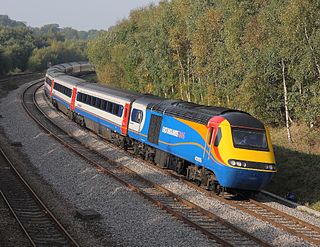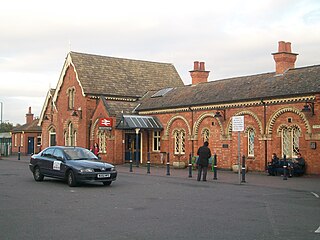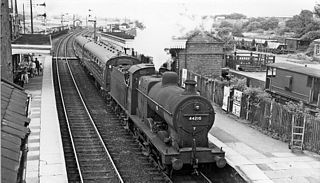
Northamptonshire is a ceremonial county in the East Midlands of England. It is bordered by Leicestershire, Rutland and Lincolnshire to the north, Cambridgeshire to the east, Bedfordshire, Buckinghamshire, Oxfordshire to the south and Warwickshire to the west. Northampton is the largest settlement and the county town.

The Midland Main Line (MML) is a major railway line from London to Sheffield in Yorkshire via the East Midlands. It comprises the lines from London's St Pancras station via Leicester, Derby/Nottingham and Chesterfield.

Raunds is a market town in North Northamptonshire, England. It had a population of 9,379 at the 2021 census.

Rushden is a town and civil parish in North Northamptonshire, England, around 18 miles (29 km) east of Northampton. The parish is on the border with Bedfordshire, 12 miles (19 km) north of Bedford.

East Northamptonshire was a local government district in Northamptonshire, England, from 1974 to 2021. Its council was based in Thrapston and Rushden. Other towns included Oundle, Raunds, Irthlingborough and Higham Ferrers. The town of Rushden was by far the largest settlement in the district. The population of the district at the 2011 Census was 86,765.

The A45 is a major road in England. It runs east from Birmingham past the National Exhibition Centre and the M42, then bypasses Coventry and Rugby, where it briefly merges with the M45 until it continues to Daventry. It then heads to Northampton and Wellingborough before running north of Rushden and Higham Ferrers and terminating at its junction with the A14 in Thrapston.

The Rushden, Higham and Wellingborough Railway is a heritage railway operated by the Rushden Historical Transport Society in the town of Rushden in the county of Northamptonshire, England.

Wellingborough is a constituency in Northamptonshire represented in the House of Commons of the UK Parliament. The seat is currently held by Labour MP Gen Kitchen, after the recall of MP Peter Bone in December 2023 which resulted in a by-election in February 2024.

Wellingborough railway station is a Grade II listed station located in the market town of Wellingborough in Northamptonshire, England. It lies on the Midland Main Line and is 65 miles (104 km) from London St. Pancras. The station is operated by East Midlands Railway, which is also the primary operator serving the station with passenger services under the Luton Airport Express brand.

Irchester is a village and civil parish in North Northamptonshire, two miles (3 km) south-east of Wellingborough and two miles south-west of Rushden. The population of the village at the 2011 Census was 5,706 and estimated in 2019 at 5,767. Little Irchester and Knuston also lie in the parish.
Higham Ferrers is a former railway station on the Higham Ferrers branch line from Wellingborough. It served the market town of Higham Ferrers, Northamptonshire, England.

North Northamptonshire is one of two local government districts in Northamptonshire, England. It is a unitary authority area forming about one half of the ceremonial county of Northamptonshire. It was created in 2021. Its council is based in Corby, the district's largest town. Other notable towns are Kettering, Wellingborough, Rushden, Raunds, Desborough, Rothwell, Irthlingborough, Thrapston and Oundle.

Wellingborough London Road railway station is a former railway station in Wellingborough, Northamptonshire on a line which connected Peterborough and Northampton.

Glendon and Rushton railway station is a Grade II listed former railway station in Rushton, Northamptonshire.
The Northampton and Peterborough Railway was an early railway promoted by the London and Birmingham Railway (L&BR) to run from a junction at Blisworth on the L&BR main line to Northampton and Peterborough, in England. The construction of the line was authorised by Parliament in 1843 and the 47 mile line opened in 1845. The line largely followed the river Nene, and for the economy of construction, it had many level crossings with intersecting roads, rather than bridges. In 1846 the L&BR joined with other companies, together forming the London and North Western Railway (LNWR).
Rushden Parkway railway station is a proposed new railway station to serve the village of Irchester in Northamptonshire, England. It would also serve the nearby towns of Higham Ferrers and Rushden.

Raunds railway station is a railway station that once served the town of Raunds in Northamptonshire, England. The railway station was an intermediate stop on the Kettering, Thrapston and Huntingdon Railway line that closed in 1959.
The Kettering, Thrapston and Huntingdon Railway was an English railway line opened throughout in 1866. It connected the Midland Railway main line at Kettering to ironstone deposits to the south-east of the town, as well as opening up the agricultural district around Thrapston and reaching the regional centre of Huntingdon. The hoped-for expansion of agricultural was limited and local traffic did not develop; at the same time the difficult alignment and gradients of the line discouraged heavy use as a through line. A basic passenger service operated through from Kettering to Cambridge, by using running powers east of Huntingdon via St Ives.














